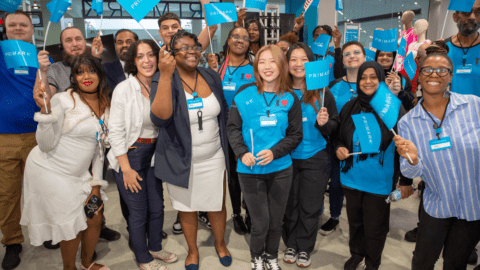Part II of a three-part series. Part I appeared in the December 8 Newsletter.
The top pressure driving executive investment in Business Intelligence (BI) is poor visibility into day-to-day operations, according to Aberdeen’s recent BI trend study. Leading retailers, including Donna Karan, Casual Male Retail Group (CMRG) and VIP Auto share their insights into successful BI initiatives in Part II of the Retail TouchPoints BI report.
Donna Karan addresses the need for greater visibility into day-to-day operations with BI tools allowing better drill-down capabilities. A long-time IBM Cognos user, Donna Karan is no stranger to enhanced visibility: With the IBM Cognos BI tools, the leading fashion design house already improved its view of its entire financial plan; gained a unified visual of its global enterprise, from wholesale operations and retail store to licensing parties; has reduced time spent on consolidating financial numbers; can make changes to global assumptions quickly; and has streamlined its budgeting cycle.
Advertisement
After realizing it had “outgrown” its current Cognos application, Donna Karan enhanced its BI position by incorporating the IBM Cognos TM1 BI product, according to Chris Gaffney, Senior Director, Financial Systems for Donna Karan. Project implementation began June 2011 and finishing three months later. IBM Cognos TM1 now provides a complete, dynamic environment for developing timely, reliable and personalized forecasts and budgets.
Gaffney told Retail TouchPoints that the recent adoption of TM1 brought many BI benefits to Donna Karan’s operations. Among the company’s new capabilities, Gaffney said that at the back end, “allocation running time was cut from three hours to ten minutes, budget cycles [may be] set up daily, and complete financial results can now be seen in minutes.
Gaffney sees the BI application moving to retail store operations reporting to track daily store sales by person, traffic-to-sales conversion rates, sales to wage percentages and square footage sales percentages,” he said. “We may also leverage the tool to plan daily retail sales and product sell-through from our wholesale customers using EDI data.”
VIP Auto, the largest privately-held U.S. automotive aftermarket retail chain, uses QlikView to increase visibility of data throughout the organization, said Dan Grosz, Vice President of IT for VIP Auto. The company’s challenge was to replace its one-dimensional merchandising hierarchy reporting with multilevel merchandising and business level views. It wanted to integrate disparate data from multiple systems and increase visibility of operational KPIs. Today the chain can match data views to the specific needs of each end user and synthesize data from multiple systems for integrated analysis, reporting and information sharing. It also has moved from green-bar and spreadsheet reporting to real-time operational scorecards while identifying operational issues and tracking progress against them.
“Our CEO can now drill down through corporate data right to the SKU level,” said Grosz. “At the same time, district managers have access to the same performance-based reports and can share them with store-level executives.”
Minimizing Reliance on Spreadsheets
Part of increased visibility as well as more flexible BI data views is a reduced reliance on static spreadsheets. One of the benefits Donna Karan first realized from IBM Cognos was the elimination of about 170 spreadsheets used in the wholesale channel alone. Gaffney previously reported that Donna Karan was “shackled to spreadsheet software,” he claimed. “We had hundreds of spreadsheets that people were going through and updating. Users would change entire sheets or links if a number changed. If a link was broken, or data didn’t come through properly the first time, we had to spend time looking for the incomplete or incorrect numbers.”
The move to Cognos BI’s more flexible reporting environment brought the most time efficiencies to the corporate level, where allocations were dramatically reduced from two to five days to just over an hour. Gaffney said efficiencies also were gained in the retail allocation process, where Donna Karan saved another one to two days.
Casual Male Retail Group (CMRG) also minimized its reliance on spreadsheets while keeping in-stock positions higher and optimizing markdowns. With a combination of tools from MicroStrategy and QuantiSense, the company increased its business intelligence particularly as it relates to assortments and margins. As the largest specialty retailer of big and tall men’s apparel, with nearly 500 stores and millions of store SKU combinations, CMRG needed to drill down from spreadsheet summary information to the deepest level of detail to optimize its localized assortments. The combined solution from MicroStrategy and QuantiSense provides personalized dashboards and exception reporting to pinpoint problems and opportunities, and increase margins.
During 2011, CMRG launched a new store format, Destination XL, using QuantiSense as its platform for business transformation. With 16 Destination XL stores opening by the end of 2011 and about 40 stores planned in 2012, CMRG relies on the QuantiSense BI tool primarily for Destination XL merchandising decisions. The tool supports CMRG’s new and complex merchandising hierarchy (with overlapping products to legacy brands, which complicated year-to-year analysis) and the local assortment challenges CMRG faces serving a very unique customer.
QuantiSense helps CMRG combine retail business intelligence, data warehousing and sophisticated analytics into role-based, actionable and repeatable retail merchandising business processes. The solution empowers the retailer to play offense with Big Data and dramatically improve sales, margins and inventory productivity.
In stark contrast to spreadsheets and legacy systems, the QuantiSense platform provides executive dashboards and personalized Playbooks designed to deliver intuitive business graphics via desktop or mobile access that empower CMRG to identify trends and exception reports and highlight problems quickly, accelerating the decision making process. Then QuantiSense Playbooks ensure consistent use of best practices for team members ranging from merchandising executives, buyers, allocators, and planners to store operations.
Part III of the Retail TouchPoints BI report will appear in the December 29, 2011 newsletter.








